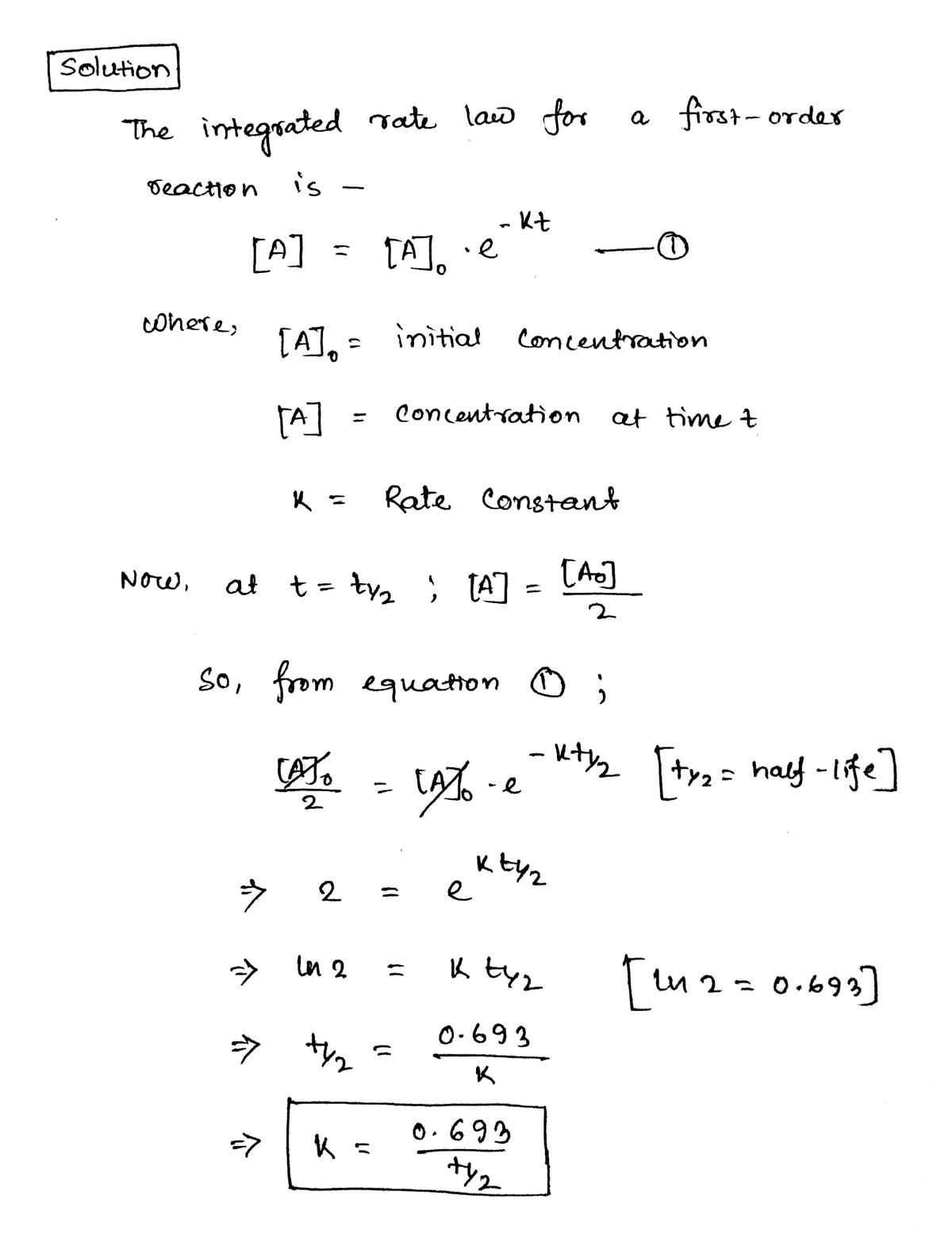The integrated rate law allows chemists to predict the reactant concentration after a certain amount of time, or the time it would take for a certain concentration to be reached. The integrated rate law for a first-order reaction is: What the rate constant of a first-order reaction that takes 307 seconds for the reactant concentration to drop to half of its initial value? Express your answer with the appropriate units. [A] = [A]ge kt > View Available Hint(s) Now say we are particularly interested in the time it would take for the concentration to become one-half of its initial value. Then we could substitute for [A and ? rearrange the equation to: Value Units 0.693 This equation calculates the time required for the reactant concentration to drop to half its initial value, In other words, it calculates the half-life. Submit
The integrated rate law allows chemists to predict the reactant concentration after a certain amount of time, or the time it would take for a certain concentration to be reached. The integrated rate law for a first-order reaction is: What the rate constant of a first-order reaction that takes 307 seconds for the reactant concentration to drop to half of its initial value? Express your answer with the appropriate units. [A] = [A]ge kt > View Available Hint(s) Now say we are particularly interested in the time it would take for the concentration to become one-half of its initial value. Then we could substitute for [A and ? rearrange the equation to: Value Units 0.693 This equation calculates the time required for the reactant concentration to drop to half its initial value, In other words, it calculates the half-life. Submit
Chemistry
10th Edition
ISBN:9781305957404
Author:Steven S. Zumdahl, Susan A. Zumdahl, Donald J. DeCoste
Publisher:Steven S. Zumdahl, Susan A. Zumdahl, Donald J. DeCoste
Chapter1: Chemical Foundations
Section: Chapter Questions
Problem 1RQ: Define and explain the differences between the following terms. a. law and theory b. theory and...
Related questions
Question
![Part B
The integrated rate law allows chemists to predict the
reactant concentration after a certain amount of time, or
the time it would take for a certain concentration to be
reached.
What is the rate constant of a first-order reaction that takes 307 seconds for the reactant concentration to drop to half of its initial value?
The integrated rate law for a first-order reaction is:
Express your answer with the appropriate units.
[A] = [A]oe kt
• View Available Hint(s)
Now say we are particularly interested in the time it would
take for the concentration to become one-half of its initial
[A],
for [A] and
?
value. Then we could substitute
2
rearrange the equation to:
Value
Units
0.693
t1/2 =
k
This equation calculates the time required for the
reactant concentration to drop to half its initial value. In
other words, it calculates the half-life.
Submit](/v2/_next/image?url=https%3A%2F%2Fcontent.bartleby.com%2Fqna-images%2Fquestion%2F87faf35d-bdff-4fde-b9fe-6459d170f061%2F1d52465a-7fd3-41ee-beb5-afd59ad7eccc%2F1qkzmha_processed.jpeg&w=3840&q=75)
Transcribed Image Text:Part B
The integrated rate law allows chemists to predict the
reactant concentration after a certain amount of time, or
the time it would take for a certain concentration to be
reached.
What is the rate constant of a first-order reaction that takes 307 seconds for the reactant concentration to drop to half of its initial value?
The integrated rate law for a first-order reaction is:
Express your answer with the appropriate units.
[A] = [A]oe kt
• View Available Hint(s)
Now say we are particularly interested in the time it would
take for the concentration to become one-half of its initial
[A],
for [A] and
?
value. Then we could substitute
2
rearrange the equation to:
Value
Units
0.693
t1/2 =
k
This equation calculates the time required for the
reactant concentration to drop to half its initial value. In
other words, it calculates the half-life.
Submit
Expert Solution
Step 1

Step by step
Solved in 2 steps with 2 images

Knowledge Booster
Learn more about
Need a deep-dive on the concept behind this application? Look no further. Learn more about this topic, chemistry and related others by exploring similar questions and additional content below.Recommended textbooks for you

Chemistry
Chemistry
ISBN:
9781305957404
Author:
Steven S. Zumdahl, Susan A. Zumdahl, Donald J. DeCoste
Publisher:
Cengage Learning

Chemistry
Chemistry
ISBN:
9781259911156
Author:
Raymond Chang Dr., Jason Overby Professor
Publisher:
McGraw-Hill Education

Principles of Instrumental Analysis
Chemistry
ISBN:
9781305577213
Author:
Douglas A. Skoog, F. James Holler, Stanley R. Crouch
Publisher:
Cengage Learning

Chemistry
Chemistry
ISBN:
9781305957404
Author:
Steven S. Zumdahl, Susan A. Zumdahl, Donald J. DeCoste
Publisher:
Cengage Learning

Chemistry
Chemistry
ISBN:
9781259911156
Author:
Raymond Chang Dr., Jason Overby Professor
Publisher:
McGraw-Hill Education

Principles of Instrumental Analysis
Chemistry
ISBN:
9781305577213
Author:
Douglas A. Skoog, F. James Holler, Stanley R. Crouch
Publisher:
Cengage Learning

Organic Chemistry
Chemistry
ISBN:
9780078021558
Author:
Janice Gorzynski Smith Dr.
Publisher:
McGraw-Hill Education

Chemistry: Principles and Reactions
Chemistry
ISBN:
9781305079373
Author:
William L. Masterton, Cecile N. Hurley
Publisher:
Cengage Learning

Elementary Principles of Chemical Processes, Bind…
Chemistry
ISBN:
9781118431221
Author:
Richard M. Felder, Ronald W. Rousseau, Lisa G. Bullard
Publisher:
WILEY